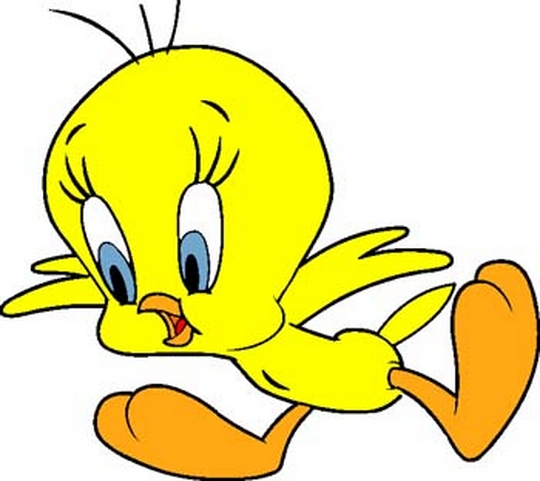
Tweety Bird Cartoon Free Downloading

Tweety in the Friz Freleng design. This is also his current appearance. First appearance (early version) November 22, 1941 (official version) produced in 1942 (official version) released on July 11, 1942 Created by (original) (redesign) Voiced by (1942–1989) (1990–1993, 2011–present) (1990–present) (1994) (1995–2003, 2011) (1996–2003) (2001–2006) (2003) (2018–present) () Information Alias Tweety Bird Tweety Tweety Pie Species Yellow canary Family Henry Bird (father) Loretta Bird (mother) 4 unnamed siblings Nationality Tweety Bird is an animated in the and series of animated cartoons. The name 'Tweety' is a play on words, as it originally meant 'sweetie', along with 'tweet' being a typical English for the sounds of. His characteristics are based on 's famous 'Mean Widdle Kid.' Tweety appeared in 47 cartoons during the.
Contents • • • • • • • • • • • • • • • • • • • Personality and identity [ ] Despite the perceptions that people may hold, owing to the long eyelashes and high pitched voice (which provided), Tweety is male although his ambiguity was played with. For example, in the cartoon, when Granny entered a room containing Tweety and she said: 'Here I am, boys!' , whereas a 1951 cartoon was entitled [emphasis added]. Also, his species is ambiguous; although originally and often portrayed as a young, he is also frequently called a rare and valuable 'tweety bird' as a plot device, and once called 'the only living specimen'. Nevertheless, the of The Sylvester & Tweety Mysteries directly states that the bird is a canary.
Www do you know female version mp3 download. Do You Know Song Female Version title/name of Song / Music / Video is delivered from Youtube and maybe containing a video's copy right. This web just only a search.
Tweety PNG & Tweety Transparent Clipart Free Download - Tasmanian Devil Tweety Bugs Bunny Sylvester Melissa Duck - Congratulations, Tasmanian devil Bugs Bunny Tweety Looney Tunes - casita, Gfycat Clip art - others.
His shape more closely suggests that of a baby bird, which is what he was during his early appearances (although the 'baby bird' aspect has been used in a few later cartoons as a plot device). The yellow feathers were added but otherwise he retained the baby-bird shape.
In his early appearances in cartoons, Tweety is a very aggressive character who tries anything to foil his foe, even kicking his enemy when he is down. One of his most notable malicious moments is in the cartoon Birdy and the Beast. A cat chases Tweety by flying until he remembers that cats cannot fly, causing him to fall.
Tweety says sympathetically, 'Awww, the poor kitty cat! He faw down and go ( in a loud, tough, masculine voice) BOOM!!'
And then grins mischievously. A similar use of that voice is in A Tale Of Two Kitties when Tweety, wearing an 's helmet, suddenly yells, 'Turn out those lights!' Tweety's aggressive nature was toned down when started directing the series, with the character turning into a more cutesy bird, usually going about his business, and doing little to thwart Sylvester's ill-conceived plots, allowing them to simply collapse on their own; he became even less aggressive when was introduced, but occasionally Tweety still showed a malicious side. Creation by Bob Clampett [ ]. Tweety's debut in created the character that would become Tweety in the 1942 short, pitting him against two hungry cats named (based on the famous comedians ).
On the original model sheet, Tweety was named Orson which was based on the model sheets in the early 40s (which was also the name of a bird character from an earlier Clampett cartoon ). Tweety was created not as a domestic canary, but as a generic (and wild) baby bird in an outdoors nest: naked (pink), jowly, and also far more aggressive and saucy, as opposed to the later, more well-known version of him as a less hot-tempered (but still somewhat ornery) yellow canary. In the documentary, animator Clampett stated, in a 'aside' to the audience, that Tweety had been based 'on my own naked baby picture'. Clampett did two more shorts with the 'naked genius', as a -ish cat once called him in. The second Tweety short,, finally bestowed the baby bird with his new name, and gave him his blue eyes. Many of 's characters are known for speech impediments.
One of Tweety's most noticeable is that /s/, /k/, and /g/ are changed to /t/, /d/, or (final s) /θ/; for example, 'pussy cat' comes out as 'putty tat', later rendered 'puddy tat', and 'sweetie pie' comes out as 'tweetie pie', hence his name. He also has trouble with: as with, /l/ and /r/ come out as /w/. In and, he begins the cartoon by singing a song about himself, 'I'm a tweet wittow biwd in a gilded cage; Tweety'th my name but I don't know my age. I don't have to wuwy and dat is dat; I'm tafe in hewe fwom dat ol' putty tat.' (Translation: 'I'm a sweet little bird in a gilded cage.' ) Aside from this speech challenge, Tweety's voice is that of 's, done a speed up only (if, which depicts Bugs as an infant, is any indication of that); the only difference is that Bugs doesn't have trouble pronouncing /s/, /k/ and /g/ as mentioned above. Freleng takes over [ ] Clampett began work on a short that would pit Tweety against a then-unnamed, lisping black and white cat created by in 1945.